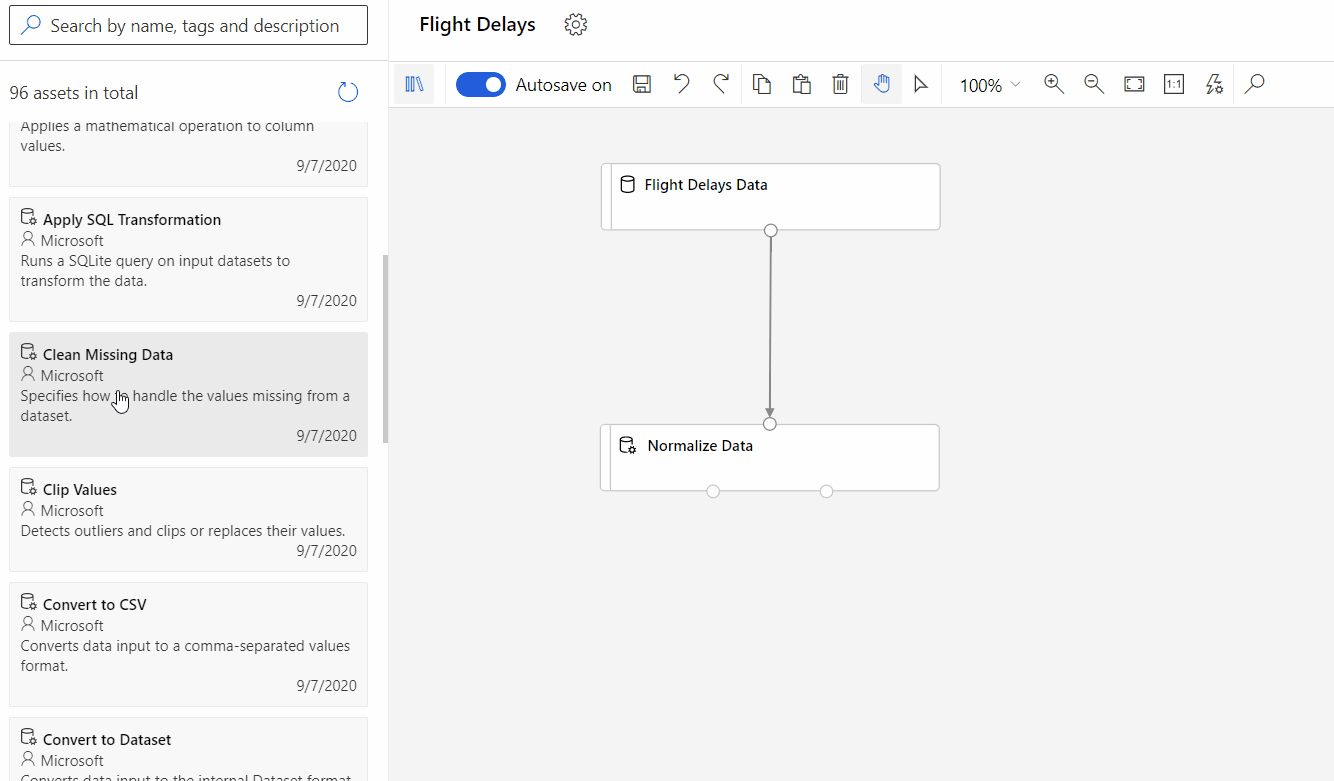Wiweeki’s Digital Transformation Story
Defining Digital Transformation
The digital transformation process looks different for everyone, depending on the business’s needs. It can be an entire company-wide change, or something as simple as transforming a single analog process to a digital process. Digital transformation encompasses a wide range of technologies and can be implemented in any business sector. To summarize, digital transformation is creating a new business model or transforming a business process using technology to improve efficiency. Some consider the idea to be more of a business transformation that is enriched by the use of technology.
Digital Transformation = Business Transformation + Technology
The key to a successful digital transformation is focusing on the people and processes side of the transformation. Likewise, if your business implements all these new technologies and processes, yet no one knows how to use them, then the transformation is of no use.
Core Elements of Digital Transformation
Understanding customer needs
It is essential to understand the business, the needs of the business, and the needs of the end-users to implement a successful digital transformation. One solution will not be the right fit for every organization. For this purpose, understand what is needed and then build from that understanding.
Optimizing business processes
Digital transformation is all about converting complicated, ineffective, and outdated processes into optimal and innovative processes that bring growth to the organization.
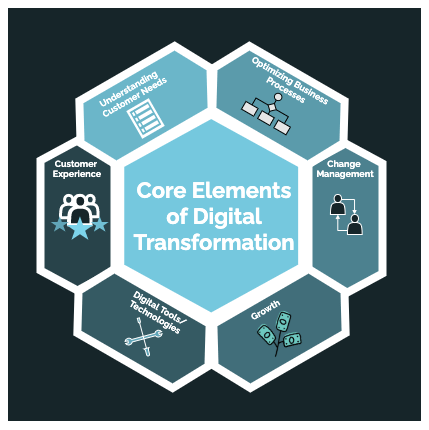
Change management
Change management is a major focal point of digital transformation because transforming inevitably brings change. Organizations need to know how to successfully manage the change by training employees to become comfortable with new tools and encouraging new and improved mindsets.
Growth
Any organization needs to continue to grow, whether it be customer growth, growth in revenue, or personal growth. Digital transformation allows organizations to continue to grow by optimizing their business processes and adapting to change.
Digital tools/technologies
While digital transformation is focused on people and processes, it is always implemented by using the latest digital technologies. It is important to understand the organization to determine what technologies are needed to be successful in the optimization of a process. Having the right technology for the right process will exponentially help in the digital transformation.
Customer experience
Organizations need customers to continue growing and to maintain the business. Therefore, the customer experience needs to be a good one. Digital transformation aims to make things easier for customers, such as getting to a certain module in 2 clicks rather than 3.
The Need For Digital Transformation
New Technology and the World Wide Web
The advances in technology are growing at a rapid rate. With the advent of the World Wide Web, numerous technologies have been created to accompany its capabilities, specifically artificial intelligence, the internet of things (IoT), blockchain, and robotics. New and upcoming businesses are immediately diving into these technologies at the very beginning and using them to optimize their business growth. Accordingly, the competition has shifted towards the younger and digitally enhanced companies, and larger, older companies have to keep up to remain at the top.
A Shift in Competition
A decade ago, the top five firms of the S&P 500 index were Exxon, GE, Microsoft, Gazprom, and Citigroup with Microsoft being the only truly digital company. Today, the top five firms are Apple, Alphabet, Microsoft, Amazon, and Facebook, all companies that continuously transform to improve their business. As we can see, Microsoft is the only one to have survived this switch in competition. To remain competitive in today’s world, digital transformation is essential. Without digital transformation, the evolution of a company will be slow or remain stagnant if they do not adapt to change.

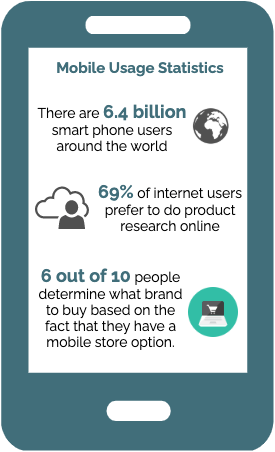
A Shift in Customer Behavior
It only makes sense to transform to a digital space. A majority of people have already immersed themselves in the digital world by keeping their phones by their sides at all times. The use of mobile phones has changed customer behavior. There are about 6.4 billion smartphone users worldwide in 2021, which is about 80% of the world’s population. Similarly, statistics show that 69% of internet users prefer to do product research online rather than asking an in-store employee, with 6 out of 10 people determining what brand to buy based on the fact that they have a mobile store option. Based on these statistics, it is clear that successfully digitally transforming your business will foster major customer growth and improve the customer experience.
As we continue to culturally shift towards a more digital world and worldly problems become more apparent, the need for digital transformation will only increase and become more urgent. “Real-world problems will always dictate business decisions and how they will rise to solve these problems, what new technologies they will invent, and what processes they will reinvent,” says Venkatesh Kalluru, CTO of Wiweeki.
Phases Of Digital Transformation
Now that we know what digital transformation is and why it’s needed, how is it done? There are three phases of digital transformation: digitize, digitalize, and transform. Before these three phases are implemented, it is important to fully understand the business needs and what they are trying to accomplish to produce a result that they are satisfied with. Once all of the requirements are laid out, it’s time to begin the digital transformation.
Digitize
The process of digitization involves taking analog information and converting it to digital information. This could mean changing analog tasks to digital tasks, integration of IT with existing tasks, or taking analog documentation and converting it into a digital format that computers can store and process. Digitization only converts the existing analog information but does not change or add any value. For example, you have a business process of renting units to tenants. Part of that process is getting applications from prospective tenants and reviewing the applications. Before, these applications may be printed out and sent to the property management office. One way of digitizing this process would be to make them available online for the tenant to fill out and submit.
Digitalization
Digitalization involves how technology can be used to change or add value to existing business processes. This is where we will determine what technologies will be used to optimize the business process. According to research published in the Journal of Business Research,
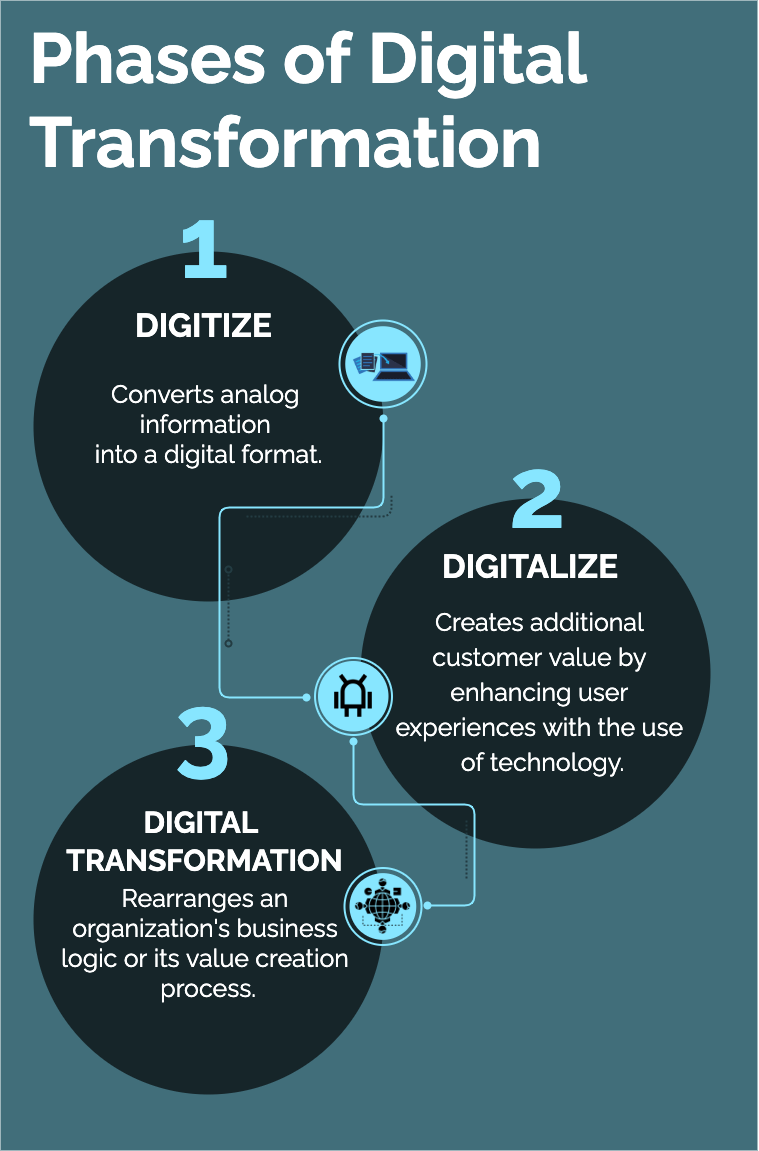
“In digitalization, IT serves as a key enabler to seize new business possibilities by changing existing business processes such as communication, distribution, or business relationship management.“ Digitalization creates additional customer value by enhancing user experiences with the use of technology. For example, now that you have the application online, you can have software read, analyze, and score the applications for you based on values in the application. You can also automatically do a credit check on the applicant.
Digital Transformation
Digital transformation is the overall company-wide change that results from digitizing and digitalizing a process. It can rearrange an organization’s business logic, its value creation process, or one simple process. Innovative business models can be brought in as a result of implementing digital technology. Employees are trained on how to optimize the newly implemented digital technologies. Since entire business logic can change in this phase, the entire employee mindset needs to evolve to accommodate these changes. Digital transformation is just as much about transforming people as it is technology, whether it be a small change or a drastic change. For example, the rent business process doesn’t drastically change by digitizing and digitalizing the application step, but doing so could spark inspiration to continue to transform and improve the entire business logic.
Learn more about Digital transformation: A multidisciplinary reflection and research agenda
Benefits of Digital Transformation
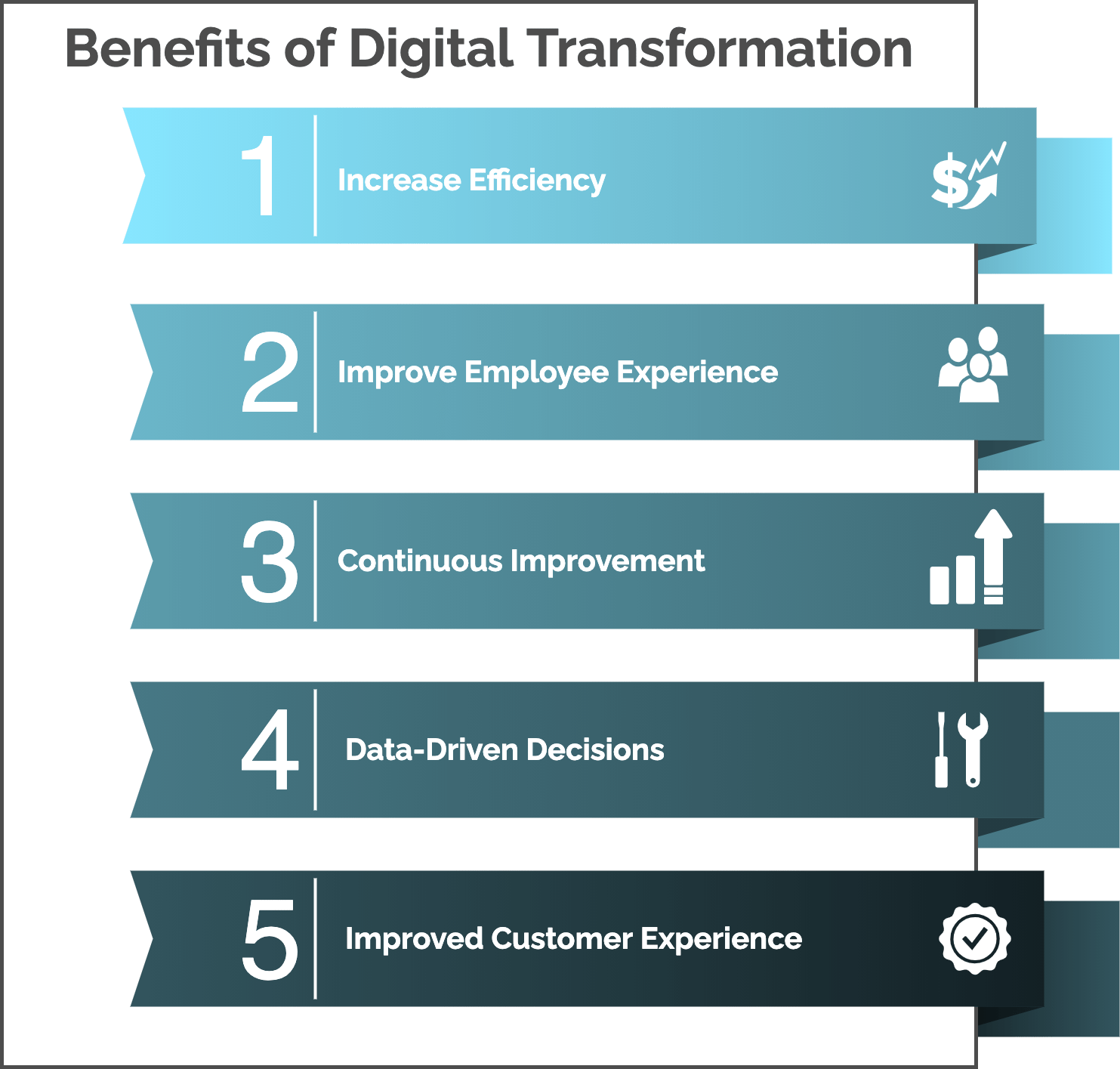
Increase Efficiency
Increasing efficiency is the number one goal of digital transformation. Improving business processes means optimizing the processes. As a result, more efficient workflows are created that generates the most overall growth. Digital transformation increases efficiency not only through innovative technology solutions but also through changing the mindsets of the employees and training them to use the technology tools.
Improve Employee Experience
Digital transformation can drastically improve the employee experience by reducing mundane tasks through tools such as automation. When working with mundane tasks every day, it is easy to become bored with the work and employees may overlook certain things or not perform to their best ability. By automating these tasks, human resources can focus on the areas that require human brains. Therefore, they can add more value to the company.
Continuous Improvement
Digital transformation is an evolutionary process. Organizations transform in iterations by implementing a transformation, monitoring it for however long the life cycle is, collecting more data, and then transforming again. Change is all around us all the time, so digital transformation will allow your company to continuously improve its business processes to adapt to those changes.
Data-Driven Decisions
Digital transformation relies heavily on real-time data and historical data. Performing a digital transformation will significantly improve data collection, from the amount of data to the usefulness of the data. Because digital transformation provides businesses with much more data than before, they can make informed, data-driven business decisions that could foster growth and increase profits. Data can provide businesses with customer insights that show the customer’s behavior, what’s working, and what’s not working.
Improved Customer Experience
Digital transformation provides access to understanding customer needs and behavior. The more a company understands its customers, the more it can satisfy the customers with improvements to its products and services. According to Accenture, “A single point increase in customer experience scores can result in millions of dollars in annual growth.”
Check out this video for more insight on the benefits of digital transformation.
The Future of Digital Transformation
The need for digital transformation will always remain crucial, but how will digital transformation evolve? The old way of digital transformation starts with analyzing the business processes and defining where technology can improve processes. Then, organizations hire engineers to develop or implement those technologies, manually monitor and collect data around the process, and then manually analyze the data to determine if the transformation was successful (i.e. did the organization get a good return on their investment).
No Code Platforms
Team Wiweeki predicts that the advent of no-code platforms will dramatically change the game. “A lot of money is being spent on digital transformation and hiring software engineers to write or implement software that transforms the business process. The advent of no-code platforms will put the tools in the business’s hands so they can do the work themselves,” says Mr. Kalluru. Coding skills are unnecessary with the use of no-code platforms. No code is important for the future of digital transformation because “The person who understands the business process, who creates it and executes it, probably can’t write software.
But what if they could drag and drop the process steps, order and connect the steps, provide some metadata, and have the software automatically written that implements the process? That is essentially what no code is. You, the business person, get the ability to create the software by simply dragging and dropping,” says David Winslow, Sr. Data Scientist for Wiweeki. Putting full control into the hands of the business empowers people to do the work in the way that they want to work, rather than getting weighed down by the logistics of the business.
AI/ML Technology
Another way Wiweeki predicts digital transformation will evolve is the use of AI/ML technology. Let’s say we have created a 30 step proposal writing process that involves sending invitations, assigning tasks, holding reviews, etc. After determining that the process itself is good, the first part of the digital transformation would be to automate as many simple tasks as possible. So, we have this process that we continue to execute and then this is where AI/ML software comes in. It will keep track of what is going on, the invitations that are sent out, who are accepting them, and all of those things.
After repeating this process, AI/ML might pop up and say, “Hey! Do you realize this step only gives you about a 1% difference between the previous step and the next one? I don’t think you need this step.” According to Mr. Winslow, “AI/ML would be monitoring your business process as you are executing it. It would be able to figure out what steps you can improve, streamline, or even eliminate.” This will become an effective feedback loop, fostering iterative and continuous improvement to the process.
Shortage of Skills
One way digital transformation has evolved from the past to the present and will continue to evolve is the changing behavior of end-users. “What we will see is a shortage of skills,” says Mr. Kalluru. In fact, we have already seen this happen in the farming industry, an industry that was once fully operated by people. Tractors and other farming equipment have replaced the need for as many people, so now we see a shortage of people with those skills.
To sustainably keep up with the demand for food, more digital transformations will have to take place. Now, they are making farming equipment that drives itself with the help of IoT devices. This is something that is happening and will continue to happen in every industry sector. As the culture continues to change, we have to ask ourselves the question, is our tool evolving to accommodate the end users from a cultural point of view?
Wiweeki’s Digital Transformation
Wiweeki specializes in providing digital transformation solutions. According to Suneetha Chalasani, CEO of Wiweeki, “The purpose of digital transformation is to accelerate growth in an organization, increase revenue, and accelerate performance. Technology is the enabler of that.” In order to perform a successful digital transformation, “what Wiweeki aims to do is to really understand the business process, what they are trying to achieve, what they want the result to be, and help them improve their business process,“ says Mr. Winslow.
Wiweeki digitally transformed FPDS-NG. In their original process, they were collecting papers, scanning them, and building a database. Their business need was that they wanted to do these things a lot faster, like having faster scanners. Mr. Kalluru says, “But we came in and told them they don’t have to use this paper scanning technology. We can help go from paper to paperless with the help of APIs and other technology, and we implemented FPDS-NG with real time integration.”
What a lot of companies might do for digital transformation is to simply automate a bad business process. For example, “We worked on a client’s business process that had 300 steps to it. They said they wanted to automate this process. Instead of automating a bad process, the key was to understand the business point of view and what they were trying to accomplish, as opposed to just automating every step. Because now you still have a bad process, it’s just been automated,” says Mr. Winslow. Wiweeki takes a different approach by putting the business first and the technology second, instead of using certain technologies for the sake of using those technologies.
Conclusion
In conclusion, digital transformation is crucial to the success of organizations in today’s digital world. Wiweeki will be there to help your organization to embrace the digital change.
“It’s not the strongest of the species that survives, nor the most intelligent that survives. It is the one that is most adaptable to change.”
-Charles Darwin
Sources
Editorial Team. (2021, June 28). 8 benefits of digital transformation. Virtru. https://www.virtru.com/blog/8-benefits-digital-transformation/.
Lin, Y. (2021, August 2). 10 mobile usage statistics you should know in 2021 [infographic]. Oberlo. https://www.oberlo.com/blog/mobile-usage-statistics.
Verhoef, P. C., Broekhuizen, T., Bart, Y., Bhattacharya, A., Qi Dong, J., Fabian, N., & Haenlein, M. (2021). Digital transformation: A Multidisciplinary reflection and research agenda. Journal of Business Research, 122, 889–901. https://doi.org/10.1016/j.jbusres.2019.09.022
YouTube. (2018). Digital Transformation | What is Digital Transformation | Digital Transformation 2021 | Simplilearn. YouTube. https://www.youtube.com/watch?v=508CR1fd8ws.
YouTube. (2020). What is Digital Transformation? Here is everything you need to know. YouTube. https://www.youtube.com/watch?v=FjAq1xjBv_4.
YouTube. (2021). 5 Benefits of Digital Transformation – Take Your Business to the Next Level. YouTube. https://www.youtube.com/watch?v=XczdGwgv-1o.

